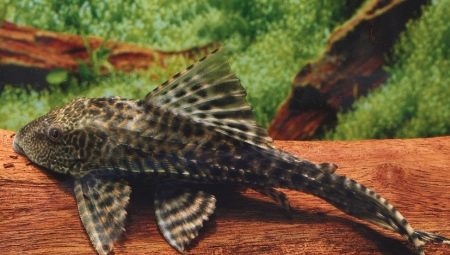Pterigoplicht (aka pteric) is a large brocade catfish native to the tropical rivers of South America. This, in general, unpretentious fish, leading a nocturnal lifestyle, will especially interest those who can afford a large aquarium with a volume of up to 500 liters, where it will feel quite satisfactory.
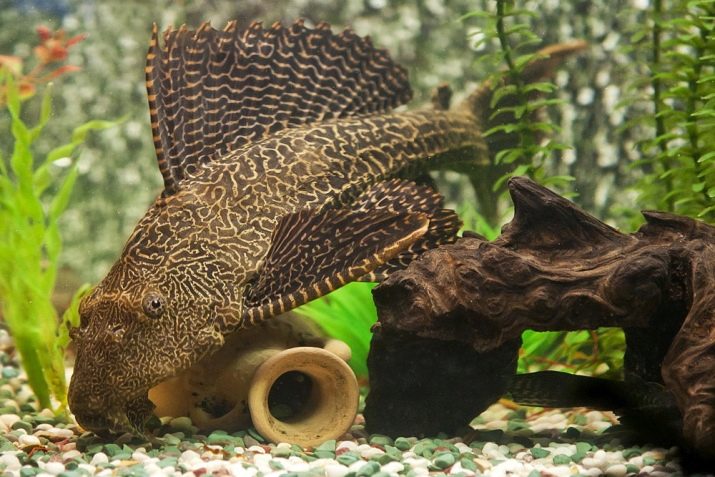
general description
Pterik is one of the largest aquarium fish, in natural reservoirs its size can reach half a meter. In an aquarium, the maximum size of the catfish directly depends on the size of the aquarium itself. If the pteric outgrows the aquarium in which it is contained, serious irreversible changes occur in his body, which are the reason for the reduction in the life expectancy of this catfish in an artificial reservoir. In aquariums, they usually live for about 15 years.
The color of the catfish pterygoplychitis varies very widely depending on age and conditions of detention. Usually the body of the catfish is covered with clearly defined irregularly shaped dark spots, fairly evenly scattered on a lighter background. The classic color resembles the skin of a giraffe. The coloration of females is usually lighter than that of males.
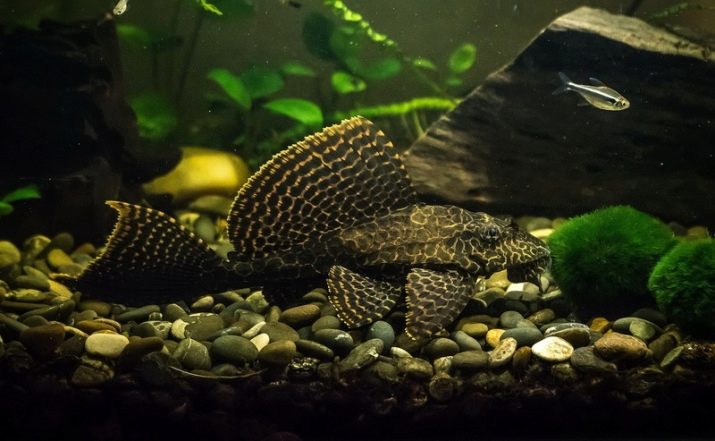
The body structure is typical of the bottom inhabitants - it is significantly compressed in the horizontal plane. The back and sides of the fish are covered with a shell of movable bone plates.
One of the features that distinguish even young pteriks from other bottom catfish-adherents is a high dorsal fin, comparable in height to the head of a catfish. There is a noticeable ridge in front of the fin on the back.
The eyes and nostrils of the pterigoplichitis have a typical high position on the head for bottom fish. The nostrils are provided with additional external outgrowths and are close in size to the eyes of the catfish. The oral apparatus of the pteric is a suction cup, combined with a thick antennae.
It is not difficult to distinguish a male from a female pterigoplichitis: the male is usually larger, but the main difference is the pectoral fins, which have longer front rays, equipped with spikes.
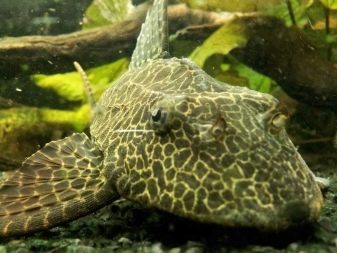
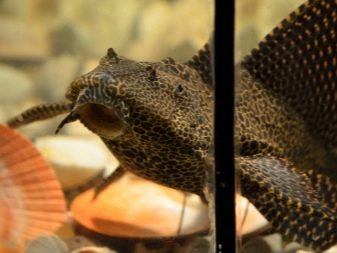
The fish is compatible with almost any neighbors in the aquarium. The basis of the diet of pterigoplichitis is plant food, and therefore it is completely indifferent to other inhabitants of the aquarium. However, herbivorous fish may end up on a starvation diet, as a larger catfish, using its suction cup, very quickly destroys food, and digs up growing algae, from which they wither and gradually die. Catfish can also be a serious nuisance for slow-moving goldfish, which are easily attached with their suction cups. In attempts to discard such a rider, the fish can completely ruin their lush fins.
Due to the large size, the pteric is not interesting for other fish. Conflicts and even accidents are possible if two or more males end up in the same aquarium, between which brawls are inevitable. Sometimes males even conflict with males of other species similar in lifestyle.
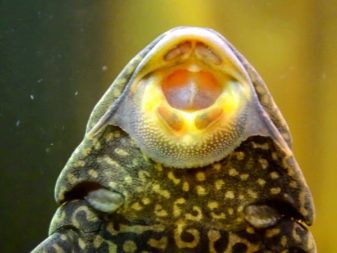
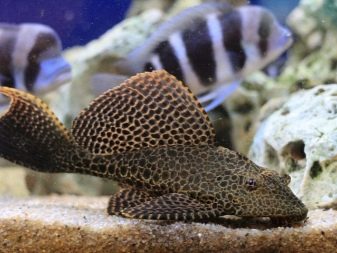
Sometimes pterigoplicht begins to starve if there are more active herbivorous fish in the aquarium. An extended abdomen usually indicates malnutrition of the catfish. Therefore, it is important to monitor the shape of the abdomen - it should remain rounded.
Kinds
Currently, at least 14 varieties of pterigoplichitis are known. Some of them are very rare and do not have a common name. All of them are inhabitants of the South American rivers of the Amazon and Orinoco basins. Some have successfully mastered the mountain rivers in the Andes, where they find shelter and food among the stones.
In the aquarium industry, the following varieties are most popular, sometimes called subspecies of pterygoprichitis.
- Leopard. Fish can grow up to 56 cm. The spots of color of this catfish are most blurred. In aquariums can live for about 10 years. The caudal fin differs inwardly pointed ends.
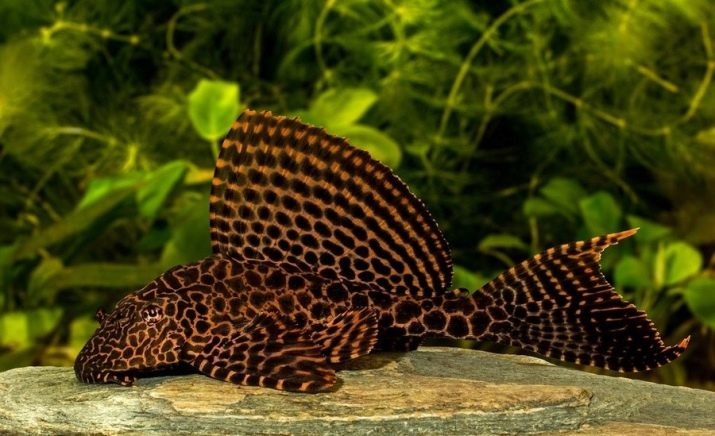
- Reticulate. May grow slightly larger than the previous variety. The color resembles a light fine-meshed mesh covering the dark body of a catfish. There are cases when in the conditions of the aquarium these catfish survived to 20 years.
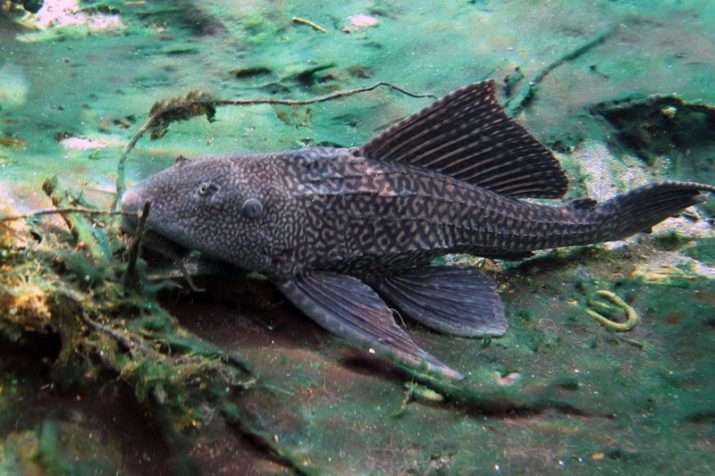
- Pterigoplicht Jozelman. The maximum body length does not exceed 35 cm. The head is pointed. The body is covered with golden spots; on the tail, the pattern becomes smaller. Life expectancy is not more than 10 years.

- Yellow sailing (orange). Reaches a length of 30 cm. Dark large spots of irregular shape cover the entire body, the spaces between them have an orange-yellow tint. Can live in a large aquarium for at least 10-15 years. A distinctive feature is the large sail-shaped dorsal fin.
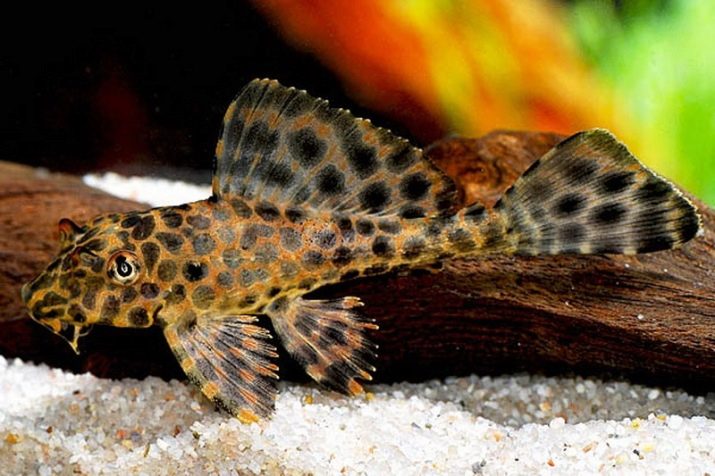
- Brocade. One of the largest subspecies. The length of the body can reach 60 cm. Large dark spots of irregular shape are scattered on a light background. He lives in aquariums up to 20 years. The dorsal fin has the shape of a sail, equipped with pronounced spikes.
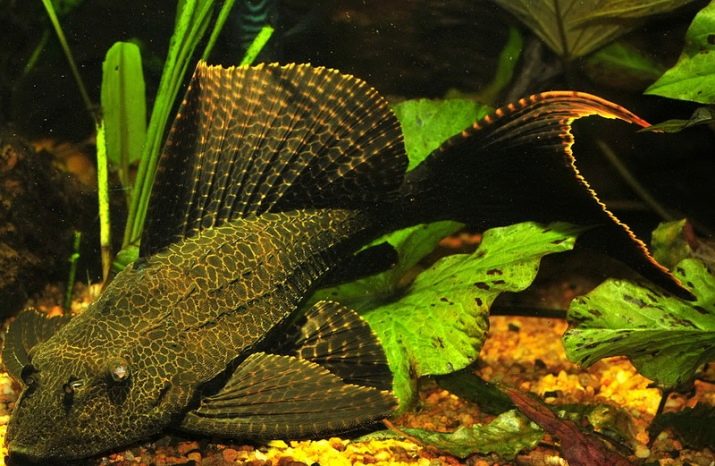
- Golden (albino). In fact, the name "albino" is arbitrary, it is an independent taxon of pterigoplichitis, and not a random genetic mutation, which are real albinos. The color of this catfish is the brightest. The overall shade is much lighter than the color of most relatives. Body length can reach 50 cm.
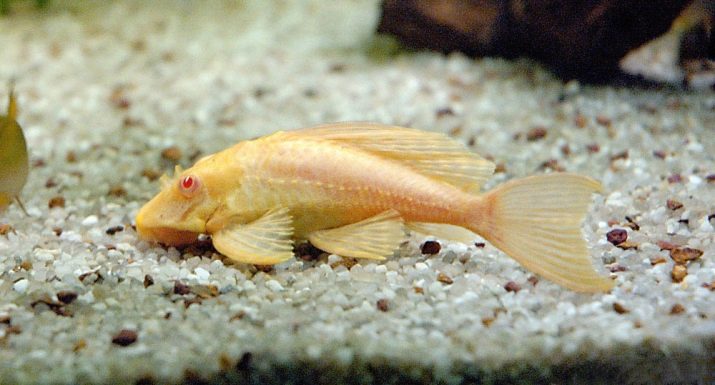
Differences from Plectostomus and Antsistrus
Often, inexperienced aquarists, buying brocade catfish for their aquarium, confuse them with very similar species: small antiscistrus and a larger plecostomus. Indeed, young animals of these species have many common features. First of all, they all belong to the shell (chain-mail) catfish, have a mouth apparatus in the form of a suction cup, and lead a bottom lifestyle. They have a similar shade of color, all have spots on their bodies. The general plan of the structure of these fish, similar in lifestyle, is actually similar.

Of course, the differences for an experienced aquarium lover or professional are obvious, but pay attention to the most significant of them is still necessary.
Plecostomus is a more common genus of fish bred in aquariums. Often an aquarium with these wonderful catfish in its own way stands out as a pteric reservoir, and this is not surprising.
Fish is widespread in the Amazon, exactly where pterigoplichitis live. The highest environmental flexibility has led to the emergence of a huge variety of subspecies of these catfish. They live in mountain streams high above sea level in the Andes, and in tropical swamps with stagnant water in the Amazon and Orinok lowlands. Moreover, everywhere they are distinguished by high numbers and fecundity.
The size of fish in natural reservoirs is very impressive - up to 50 cm, which is close to the size of pterics. In the aquarium, they can grow up to 35 cm. The color of the fish is highly variable. Dark spots prevail on a lighter background.
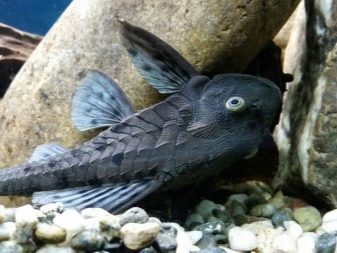
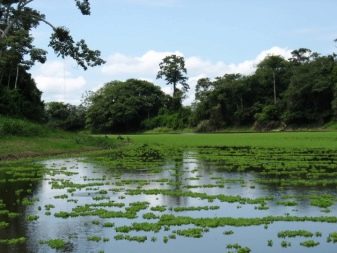
Well, now about the main differences.
- Fish, even very young ones, can be distinguished by the color of the sucker when they are on the glass. The plectostomus has a pale, thin antennae and slightly gill covers from the side of the abdomen. Pterik, on the other hand, is equipped with thick colored antennae and stained gill covers.
- The skin fold on the nostrils of the pterygoplichitis is much more developed than that of the plecostomus, and rises above eye level. In the second catfish, the fold of the nostrils is always below the line of the eyes.
- Rows of spikes on the sides of the body. Pterigoplichitis has two of them, one goes on the side of the eye level, the second starts from the pectoral fin. Spikes are quite noticeable even in young fish in a lighter color. The plecostomus has only one row of such outgrowths, going in a curved line from the pectoral fin.
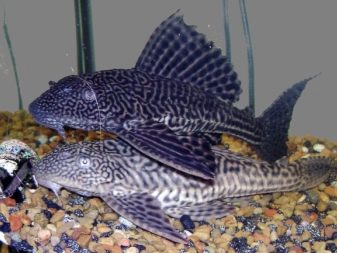
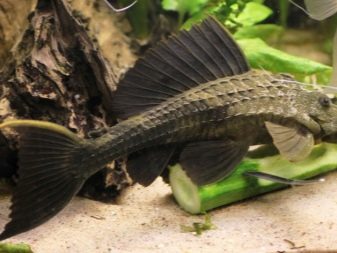
Due to the relative rarity and practically impossible in the conditions of an amateur aquarium, the reproduction of pterics is much more expensive than plecostomy.
Beginning aquarists often confuse pterika with another popular inhabitant of an artificial reservoir - catfish Antsistrus. The young of these catfish is very similar. First of all, you should pay attention to the pattern of spots - the tail of the ancistrus is as if separated from the body by a light stripe. And, of course, the head - in Antsistrus it is covered with various forms of growths, “horns”, which never happens with pterygoplychitis. Adult catfish can not be confused, at least because of differences in size: Antsistrus rarely grows more than 15 cm.

How do they live in nature?
Brocade catfish are inhabitants of the vast river systems of the Amazon and Orinoco. Since a connection is established between these river basins during the rainy season, fish can freely move from rivers to rivers in vast territories. You can meet these catfish and those close to them in their way of life in all permanent and even temporary water bodies of northern South America and the Caribbean. Some fish can live in the brackish water of river estuaries.
In the dry period, catfish caught in a drying pond hibernate, creating a rather complex hole in the silt with a length of at least 1 meter. The large habitat of the pterigoplichts included areas with different conditions, which gave rise to numerous natural varieties and subspecies of these catfish.
Food problems in fish in natural reservoirs never arise. 80% of the diet is plant food - microscopic algae, soft tissues of aquatic plants, decaying wood.
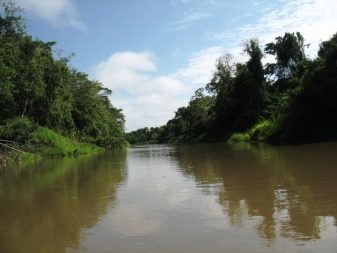
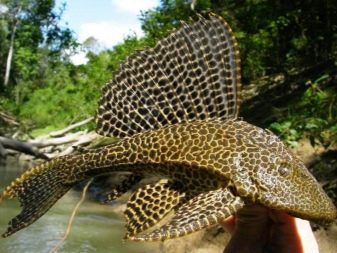
With the age of natural enemies, catfish become less and less. Durable carapace, numerous spikes on the body and fins, camouflage coloring and nocturnal lifestyle allow them to defend themselves well from predators.
Features of keeping in the aquarium
The main mistake in keeping the pteric is to place it in a small aquarium. The fish grows quite quickly, reaching impressive size. The optimal capacity for a pair of these fish is considered to be a capacity of at least 400 liters. Of course, young catfish will live well in an aquarium of up to 100 liters, but it will be impossible to create conditions satisfactory for it there after some time. This significantly reduces the life expectancy of brocade catfish.
Caring for an aquarium with pterygoplychitis does not present any difficulties. Fish lives in large and deep rivers. Water needs to be replaced about a quarter weekly. In an aquarium with brocade catfish, it is desirable to create a gentle current and necessarily aeration. To maintain cleanliness in the aquarium, an external aquarium filter is needed - large catfish can create strong turbidity.
The temperature from 24 to 30 ° С is optimal for keeping pterics, because in nature the water of slow rivers of the equatorial belt warms up very well. The stiffness is necessary average, and the pH is not lower than 6.5, and preferably 7.5.
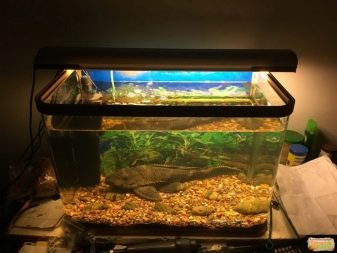
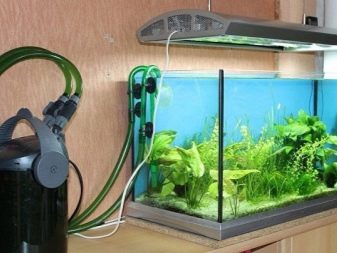
Brocade catfish - the fish is quite peaceful, so it can be kept with almost any neighbors. However, at night, when catfish is active, it can stick to the covers of slow-moving fish. Golden fish, sometimes discus or scalar, which are inactive at night, can suffer especially from his harassment. The pteric can strip the scales off their bodies, trying to cover the need for animal food.
Being a bottom inhabitant, catfish with pleasure eats fish eggs that somehow ended up in the aquarium. The presence of armor and a large size make brocade catfish compatible even with rather aggressive cichlids and some other predators.
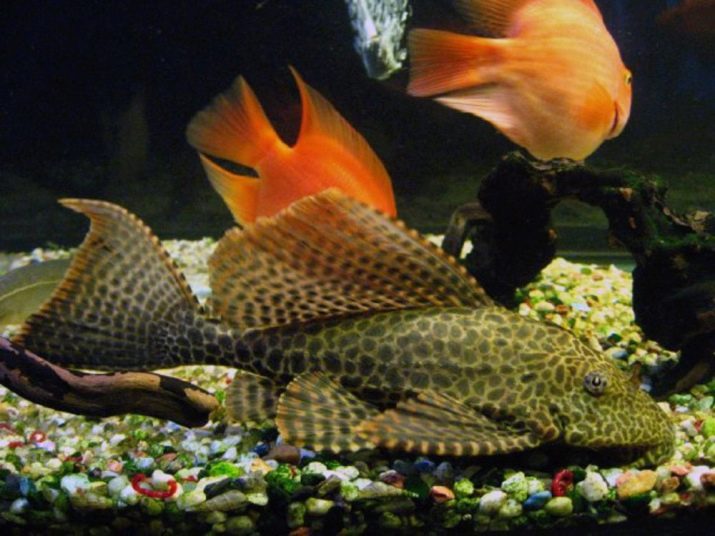
Creating a pond for him, it is necessary to take care of shelters where he will spend daylight hours, minimize natural vegetation, since it will be destroyed anyway, and discard hopes for successful reproduction of other fish in the same pond.
What to feed?
Cellulose is necessary for the digestion of pterigoplichoma catfish; in nature, they use numerous rotting trunks and tree branches as its source. Therefore, in the aquarium, which contains pterics, there must be a snag.
80% of the diet of pterigoplichitis should be plant foods. You can give spinach, cucumbers, carrots, zucchini. It is also necessary for them to purchase special combined vegetable feed. Large fish will surely eat young shoots of aquatic plants.
Of course, like many herbivorous fish, brocade catfish also need animal food. Animal feed usually makes up about 20% of the fish’s diet. Like all catfish, they pick up any leftover frozen or dried food from the bottom. In natural reservoirs, they often eat the dead inhabitants at the bottom. Pteric can catch shrimp, worms or bloodworms as live food.
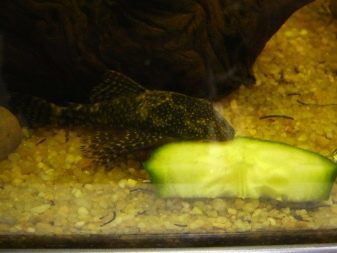
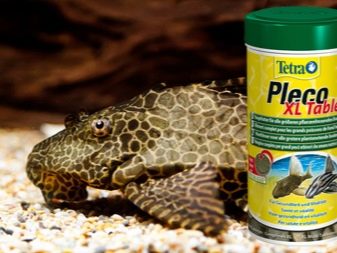
In an aquarium densely populated by different fish, brocade catfish can end up on a starvation diet, as daytime active fish almost completely eat the proposed food, leaving the soma content with only miserable leftovers. Large catfish will not be able to compensate for food shortages by eating microalgae. When the content of pterygoplychtes is necessary to monitor their proper nutrition, as often indicated by the shape of the abdomen of these fish.

An elongated hollow belly signals malnutrition and the need to change the regime and quality of fish nutrition.
Breeding
Unfortunately, cases of successful breeding of pterigoplichitis in amateur aquariums, and in professional aquarium farms, are still unknown. Under natural conditions, these fish arrange long, complex-shaped burrows on the banks and at the bottom of reservoirs, where they can successfully endure drought and also lay eggs. So far it has not been possible to create a semblance of a hole even in very large aquariums.After fertilization, the male remains in the tunnel to guard the masonry. At this time, he is quite aggressive and, having spread his fins with spikes, can attack both his careless counterparts and any swimming fish.
Sexual demorphism in these catfish is expressed rather weakly. The male, as a rule, is somewhat larger, has a brighter color and more developed spines on the fins. An adult female is distinguished by a special, so-called genital papilla, which experienced aquarists can distinguish. Fish become sexually mature at the age of 3 years.
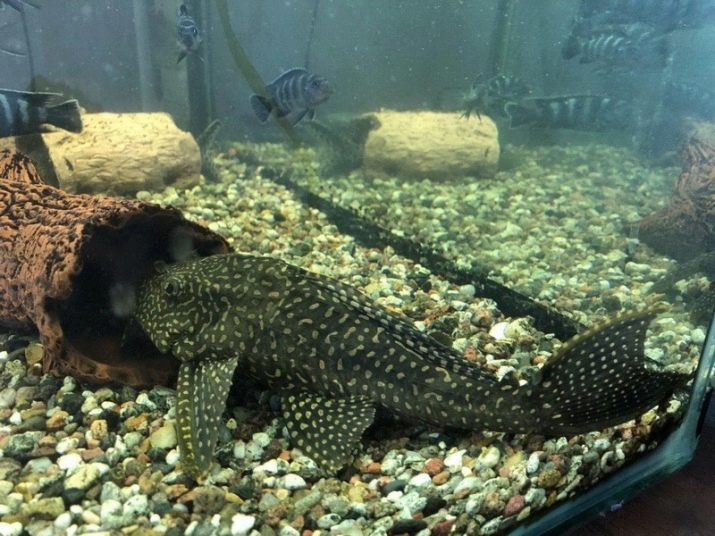
Successful breeding of brocade catfish was carried out only in large unpaved ponds in the USA, Thailand, Australia and some other tropical countries. The fish received in such professional farms goes on sale.
On how to contain brocade pterigoplichta, see the next video.
